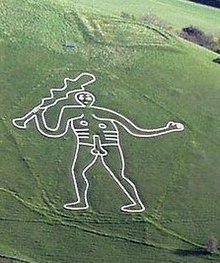 Cerne Abbas Giant chalk figure below the rectangular "Trendle" earthworks | |
| Alternative name | Cerne Giant |
|---|---|
| Location | Giant Hill, Cerne Abbas, Dorset, England |
| Coordinates | 50°48′49″N 2°28′29″W / 50.813676°N 2.474700°W |
| Type | Hill figure monument |
| Length | 55m (180ft) |
| History | |
| Material | Chalk |
| Founded | First recorded 1694 |
| Associated with | |
| Site notes | |
| Ownership | National Trust |
| Public access | Yes |
| Website | nationaltrust |
| Official name | Hill figure called The Giant |
| Designated | 15 Oct 1924 |
| Reference no. | 1003202 |
The Cerne Abbas Giant is a hill figure near the village of Cerne Abbas, in Dorset, England. It is currently owned by the National Trust, and listed as a scheduled monument of England. Measuring 55 metres (180 ft) in length, the hill figure depicts a bald, nude male with a prominent erection, holding his left hand out to the side and wielding a large club in his right hand. Like many other hill figures, the Cerne Giant is formed by shallow trenches cut into the turf and backfilled with chalk rubble.
The origin and age of the figure are unclear, and archaeological evidence suggests that parts of it have been lost, altered, or added, over time; the earliest written record dates to the late 17th century. Early antiquarians associated it, albeit on little evidence, with a Saxon deity, while other scholars sought to identify it with a Romano-British figure of Hercules (or some syncretisation of the two).[1] The lack of earlier descriptions,[2] along with information given to the 18th-century antiquarian John Hutchins, has led some scholars to conclude it dates from the 17th century. Conversely, recent optically stimulated luminescence testing has suggested an origin between the years 700 CE and 1110 CE, possibly close to the 10th-century date of the founding of nearby Cerne Abbey.[3]
Regardless of its age, the Cerne Abbas Giant has become an important part of local culture and folklore, which often associates it with fertility. It is one of England's best-known hill figures and is a visitor attraction in the region.
The Cerne Giant is one of two major extant human hill figures in England, the other being the Long Man of Wilmington, near Wilmington, East Sussex, which is also a scheduled monument.
- ^ Rodney Castleden, The Cerne Giant, Dorset Publishing Company, 1996, ISBN 978-0948699559, pp. 32–33
- ^ Hutton, Ronald (2023). Queens of the wild: pagan goddesses in Christian Europe an investigation. New Haven (Conn.) London: Yale University press. p. 23. ISBN 9780300273342.
In 1983, it was realized that there was no record of the Cerne Abbas Giant before the 17th century, in a valley with good previous records...
- ^ Morcom, Thomas; Gittos, Helen (1 January 2024). "The Cerne Giant in Its Early Medieval Context". Speculum. 99 (1): 1–38. doi:10.1086/727992. ISSN 0038-7134. S2CID 266375339.
